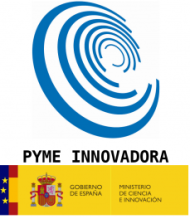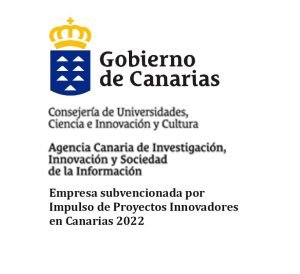Inspection tool software USER GUIDE v4.0.X
The Agnospcb Inspection software has been created to facilitate the integrity analysis of your PCBAs. The main features are:
- Auto-mapping/alignment : The tool will rotate, stretch and align the photos of the circuit /panels to be inspected facilitating the visual comparison.
- Magnification areas: detailed view of every element of the PCBAs. Adjustable with the mouse’s wheel.
- Custom color masks: Highlight the faults, no matter the color of the PCBA. Three colors available: red, green and blue.
- Auto-signalling: yellow crosses will mark the exact location of the faults detected.
- Auto Analyze: A fast way to inspect your PCBAs, with just one click, the software will do everything.
Depending on the system / Kit you have, there are two different options. Both systems use the same inspection software, but the user interface is slightly different:
1) Use the Windows OS version of the inspection tool software on your own computer / laptop.
2) If you got the Inspection platform from us and included the Raspberry 400 with the KIT, the inspection tool software is already installed in the microcomputer. Click on the image of the inspection platform below.
Select an option above, the link will lead you to the correct section.
PC System recommended Requirements
- OS:Windows 10 (64-bit)
- CPU: Intel® Core™ i5-7600 or better / Ryzen 5 2500U or better
- RAM:16GB of system memory
Internet connection
- Fiber internet service : 100-1000Mbps*
The processing time is highly dependent on the transmission speed of the internet connection. The faster the speed, the faster the inspection. Wired connection to the router is highly recommended.
To install it, download the software clicking on the button above (get the password contacting us).
Windows OS: After extracting and launching the .exe file (“AgnosPCB inspection tool vX.XX.exe), the software will locally create 4 folders: BATCH / MASTER / PCB-IN and PCB_OUT

NOTE: Additionally, you need to install the SONY DESKTOP software if you are not using our inspection platform to take the photos of your PCB/As
Folders
- BATCH: by default, the folder where the software will look for photographs during the BATCH INSPECTION process (can be changed).
- MASTERS: the suggested location of the GOLDEN SAMPLES / REFERENCES images of the PCBAs
- PCB_IN: the inspection tool will look for new images of the circuit to be inspected inside this folder. If you are using our inspection platform, you have to set this folder as the default destination for the photographs taken (check image below to see how to do it)
- PCB_OUT: the destination folder of all the inspection results images.

In the REMOTE software, go to the File menu
-> Save Folder and select the Inspection tool /PCB_IN folder as the destination for the photos. That will allow the software to find the latest photos taken to your PCBAs
Agnospcb inspection tool: User interface elements
Upon launching the Agnospcb inspection tool software the user interface will appear. It has different panels and inspection areas:
- Help Icon: click to get to this USER Guide
- User account credentials: Use your user and pass credentials to get access to the inspection process.
- Activity log: provides useful information about the inspection process.
- Settings : where the configuration ICONs are. Useful tools in your inspection process.
REFERENCE PANEL (green) : The “golden sample” image. Can be loaded using the LOAD icon (from the Reference area). - UNIT UNDER INSPECTION (orange): this is the image of the panel to be inspected. Can be loaded using the LOAD icon (from the inspection area)
- Magnification area: this frame will display, the same areas of the REFERENCE, INSPECTED and RESULT circuit/panels. Move the mouse to check different zones of the circuit. Use the mouse’s wheel to modify the zoom magnification.

CONTROL PANEL buttons

Start the inspection process. This button is enabled only after you have the REFERENCE and TO BE INSPECTED images already set. Keyboard shortcut: ENTER.

ACTION buttons
The action buttons are located in the upper right corner of the inspection areas.

LOAD photo: Use this ICON to load a “reference” or “to be inspected” photo. If you have stored a “reference” image and want to retrieve it to use it again, use this button. You can do the same with an image of a “to be inspected” circuit/ panel. This button will get non-functional if you have the AUTO-PROCESSING option enable, which will automatically process every photo taken with the camera.

CROP IMAGE: Useful when the panel/circuit in the photo is too small. Cropping the image will “force” the software to focus in the selected area. Only available in the REFERENCE canvas. The software will automatically look for the same area in every photo taken of the panels to be inspected after it has been set. To remove the CROP boundaries, click on the icon again.

Auto-signalling: In order to highlight the faults detected you have two options: 1) change the color of the faults mask using the Action button “layers” (explained below) or 2) enabling this feature. It will place a yellow cross on top of the faults detected. Not visible in the magnification areas.


Other features: ZOOM
IMPORTANT: How Error Report works
If you get false positives or faults not properly detected can be reported to us. It is very important for us to get this information, as the neural network will learn from its mistakes. If you find a reflection on a surface marked as fault, a not perfectly indicated issue anything you want us to review, just report it pressing the UP arrow key after placing the mouse’s cursor on top of it. It will take less than a second and will let the software adapt its detection capacities to your particular manufacturing process.
STARTING THE INSPECTION PROCESS
1) Signing-up + Inspecting your first PCBAs
You need an account user ID and password to use the Agnospcb Inspection tool. You can get one for free to test the service capabilities.
Populate the USER and PASSWORD fields with your details and click on SUBMIT. Your login info will be stored (encrypted) so you do no have to input them again.
The Agnospcb Inspection tool software will “compare” the photograph of your REFERENCE circuit/panel (“golden sample”) with all the photos you will take of the circuit to be inspected (photos to “ANALYZE“)

All the faults found on the inspected circuit/panel will be highlighted (if any).
 NOTE: You can manually select a “to be inspected” photo, clicking on the LOAD ICON of the “TO BE INSPECTED AREA” and select it using the TO ANALYZE button. The software will automatically rotate and align it.
NOTE: while the neural network will discard any minor differences related to lighting conditions, positional or geometric changes among the circuit/elements, we recommend placing the boards to be inspected (within the possibilities) in the same position when taking the photos.
NOTE: The inspection resulting images will be stored in the /PCB_OUT folder.
NOTE: You can manually select a “to be inspected” photo, clicking on the LOAD ICON of the “TO BE INSPECTED AREA” and select it using the TO ANALYZE button. The software will automatically rotate and align it.
NOTE: while the neural network will discard any minor differences related to lighting conditions, positional or geometric changes among the circuit/elements, we recommend placing the boards to be inspected (within the possibilities) in the same position when taking the photos.
NOTE: The inspection resulting images will be stored in the /PCB_OUT folder.
 COMPUTERS USERS: Auto Analyze
STEPS:
COMPUTERS USERS: Auto Analyze
STEPS:
- SET your REFERENCE image (Button REFERENCE)
- ENABLE “AUTO ANALYZE” ticking its box
- Take a photo of a circuit you want to inspect using the REMOTE app (You can use the key ” 1″ from your keyboard to take the photo when the REMOTE tool is active) or using your own camera system.
- The software will display the result of the inspection within seconds
- REPEAT: Take another photo of the next PCBA you want to inspect. The software will process it automatically.
Internet connection: minimum requirements
Wired internet connection or Fiber internet service speed: 100-1000Mbps*
The processing time is highly dependent on the transmission speed of the internet connection. The faster the speed, the faster the inspection. Wired connection to the router is highly recommended.
 Upon powering up the Raspberry 400 microcomputer, the Agnospcb inspection tool software user interface will appear.
Every time you power up the system, the Agnospcb inspection software with be automatically launched. Alternatively, you can launch it double-clicking on its Desktop´s shortcut.
It user interface has these panels and inspection areas:
Upon powering up the Raspberry 400 microcomputer, the Agnospcb inspection tool software user interface will appear.
Every time you power up the system, the Agnospcb inspection software with be automatically launched. Alternatively, you can launch it double-clicking on its Desktop´s shortcut.
It user interface has these panels and inspection areas:
- Help Icon: click to get to this USER Guide
- User account credentials: Use your user and pass credentials to get access to the inspection process.
- Activity log: provides useful information about the inspection process.
- Settings: where the configuration ICONs are. Useful tools in your inspection process.
- REFERENCE PANEL (green box) : The “golden sample” image. Can be loaded using the LOAD icon (from the Reference area).
- UNIT UNDER INSPECTION (orange): this is the image of the panel to be inspected. Can be loaded using the LOAD icon (from the inspection area)
- Magnification area: this frame will display, the same areas of the REFERENCE, INSPECTED and RESULT circuit/panels. Move the mouse to check different zones of the circuit. Use the mouse’s wheel to modify the zoom magnification.

CONTROL PANEL buttons
These buttons will be enabled or disabled depending on the inspection stage you are in.

IMPORTANT: How Error report works
If you get false positives or faults not properly detected can be reported to us. It is very important for us to get this information, as the neural network will learn from its mistakes. If you find a reflection on a surface marked as fault, a not perfectly indicated issue anything you want us to review, just report it pressing the UP arrow key after placing the mouse’s cursor on top of it. It will take less than a second and will let the software adapt its detection capacities to your particular manufacturing process.


Turn it OFF: This button will turn the Raspberry 400 off. If you need to get the USB DRIVE with the inspection images safely, turn the raspberry 400 off before unplug it.
ACTION buttons
The action buttons are located in the upper right corner of the inspection areas.

LOAD photo: Use this ICON to load a “reference” or “to be inspected” photo. If you have stored a “reference” image and want to retrieve it to use it again, use this button. You can do the same with an image of a “to be inspected” circuit/ panel. This button will get non-functional if you have the AUTO-PROCESSING option enable, which will automatically process every photo taken with the camera.

CROP IMAGE: Useful when the panel/circuit in the photo is too small. Cropping the image will “force” the software to focus in the selected area. Only available in the REFERENCE canvas. The software will automatically look for the same area in every photo taken of the panels to be inspected after it has been set. To remove the CROP boundaries, click on the icon again.

Auto-signalling: In order to highlight the faults detected you have two options: 1) change the color of the faults mask using the Action button “layers” (explained below) or 2) enabling this feature. It will place a yellow cross on top of the faults detected. Not visible in the magnification areas.


Faults Mask-colors: Once the analysis of the panel/circuit has been carried out, the results will be shown as a new mask on top of the image. If faults have been detected, they will be highlighted in red/blue or green. Depending on the PCBA´s color / material you are working with, you may need to change the opacity and color of the mask in order to easily pinpoint where those faults are. Every time you click on the ICON the mask color will change. Its opacity can be modified spinning the mouse’s wheel when it is placed on top of the ICON.

The INSPECTION button
 NOTE: if the AUTO ANALYZE button (icon below) has been previously activated, every time you press the INSPECTION button for a second, the image will be inspected automatically. This will help you to reduce the inspection total processing time.
NOTE: if the AUTO ANALYZE button (icon below) has been previously activated, every time you press the INSPECTION button for a second, the image will be inspected automatically. This will help you to reduce the inspection total processing time.

Inspection process
A video always helps at this point. The sequence you need to follow to start the inspection process will be this:
- Turn on the LED Panels using the remote control (ON button). You can adjust the brightness with the UP and DOWN arrows. Set it to maximum if your warehouse lighting environment is dark. Set it to about 80% of its maximum brightness for daylight working conditions.
- Turn on the Sony camera. Previously connected to the microcomputer and with the battery dummy already inserted.
- Switch on the Raspberry 400. It will check if the camera is OK, sending a set of commands that will prepare the camera for the inspection process.
- Wait for the system to boot. You will see in your monitor how the OS start and the inspection software gets ready.
- Insert your user credentials and click on SUBMIT. If there was a previous REFERENCE image, it will be loaded.
- Start your inspection process setting a REFERENCE image and then, taking photos of the circuits/ panels to be integrity checked.
NOTE: make use of the REPORT feature. That will dramatically improve the recognition capacity of the system in the long run.
NOTE: Check this quick guide about how to get the best inspection results with the inspection platform.
Troubleshooting
Software:
How do I update the software for my Raspberry 400?
Get to this page and follow instructions: how to update/ restore the Agnospcb OS (Raspberry 400 system)
I am getting “time-out” errors when inspecting my circuits. How do I solve it?
The Agnospcb inspection software needs a fast and reliable internet connection, as some areas of the photos taken will be sent to our neural network server. That means that, an internet wired connection or Fiber internet service (100-1000Mbps) is mandatory. Otherwise, the software will take over 10 seconds to process one inspection and the “time-out” error message will appear. If you need an “off-line” solution, contact us.
The camera does not respond
Check if the battery dummy is connected to the correct USB power supply, capable of delivering 3A. Always turn the camera ON, before the Raspberry 400. Check if the USB cable is properly connected and fully inserted. Does the R a S keys of the keyboard trigger the camera?
I am using a 4K monitor and the system is performing slowly.
The Raspberry 400 OS and Inspection software has been optimized to run smoothly with FULL-HD monitors (1080p). 4K monitor will decrease the overall performance of the system.
I can not log in with my credentials
If you are getting an “Unknown Error” or “Login Error” message, check if your internet connection is running in the background a firewall or if it has been capped. A quick way to narrow down the problem would be creating a mobile hotspot and connect the Raspberry 400 to it. Contact us if the issue persists.
Not an AgnosPCB client?
Contact us to get free access to the Inspection tool






